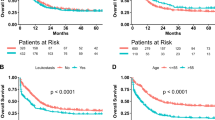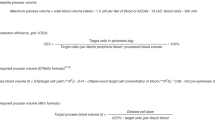Abstract
Autograft absolute lymphocyte count (A-ALC) is an independent prognostic factor for survival after autologous peripheral blood hematopoietic stem cell transplantation (APHSCT) for non-Hodgkin's lymphoma (NHL). Factors enhancing A-ALC collections are unknown. We hypothesize that apheresis instrument settings could affect A-ALC. Data from 127 NHL patients collected from 15 January 1999 to 30 July 2004 using a single apheresis instrument (COBE Spectra (SP), Baxter Amicus (AM), and CS3000 Plus (CS)) were analyzed. The primary end point of the study was to assess the correlation between apheresis instrument settings and A-ALC. The secondary end point was to determine the effect of apheresis instrument on survival post-APHSCT. Patients collected using SP achieved higher A-ALC compared to AM (with modified settings) or CS (P<0.05) and demonstrated superior overall (OS) and progression-free survival (PFS) (P<0.03). Multivariate analysis demonstrated A-ALC and not the apheresis instrument as an independent prognostic factor for OS and PFS, cancelling the prognostic effect of the apheresis instruments observed in the univariate analysis. The survival advantage observed by SP was from the higher A-ALC collected compared to AM and CS. These data suggest that apheresis instrument settings should be optimized to collect CD34+ cells as well as an A-ALC target, with direct impact on survival post-APHSCT.
This is a preview of subscription content, access via your institution
Access options
Subscribe to this journal
Receive 12 print issues and online access
$259.00 per year
only $21.58 per issue
Buy this article
- Purchase on Springer Link
- Instant access to full article PDF
Prices may be subject to local taxes which are calculated during checkout



Similar content being viewed by others
References
Porrata LF, Litzow MR, Tefferi A, Letendre L, Kumar S, Geyer SM et al. Early lymphocyte recovery is predictive factor for prolonged survival after autologous hematopoietic stem cell transplantation for acute myelogenous leukemia. Leukemia 2002; 16: 1311–1318.
Porrata LF, Ingle JN, Litzow MR, Geyer S, Markovic SN . Prolonged survival associated with early lymphocyte recovery after autologous hematopoietic stem cell transplantation for patients with metastatic breast cancer. Bone Marrow Transplant 2001; 28: 865–871.
Nieto Y, Shpall EJ, Mcniece IK, Nawz S, Beaudet J, Rosinski S et al. Prognostic analysis of the early lymphocyte recovery in patients with advanced breast cancer receiving high-dose chemotherapy with an autologous hematopoietic progenitor cell transplant. Clin Cancer Res 2004; 10: 5076–5086.
Porrata LF, Inwards DJ, Micallef IN, Ansell SM, Geyer SM, Markovic SN . Early lymphocyte recovery post autologous haematopoietic stem cell transplantation is associated with better survival in Hodgkin's lymphoma. Br J Haematol 2002; 117: 629–633.
Gordan LN, Sugrue MW, Lynch JW, Williams KD, Khan SA, Mored JS . Correlation of early lymphocyte recovery and progression-free survival after autologous stem-cell transplant in patients with Hodgkin's and non-Hodgkin's lymphoma. Bone Marrow Transplant 2003; 31: 1009–1013.
Kim H, Sohn HJ, Kim SE, Kang HJ, Park S, Kim S et al. Lymphocyte recovery as a positive predictor of prolonged survival after autologous peripheral blood stem cell transplantation in T-cell non-Hodgkin's lymphoma. Bone Marrow Transplant 2004; 34: 43–49.
Porrata LF, Gertz MA, Inwards DJ, Litzow MR, Lacy MQ, Tefferi A et al. Early lymphocyte recovery predicts superior survival after autologous hematopoietic stem cell transplantation in multiple myeloma or non-Hodgkin's lymphoma. Blood 2001; 98: 579–585.
Porrata LF, Gertz MA, Litzow MR, Lacy MQ, Dispenzieri A, Inwards DJ et al. Early lymphocyte recovery predicts superior survival after autologous hematopoietic stem cell transplantation for patients with primary systemic amyloidosis. Clin Cancer Res 2005; 11: 1210–1218.
Porrata LF, Gertz MA, Geyer SM, Litzow MR, Gastineau DA, Moore SB et al. The dose of infused lymphocytes in the autograft directly correlates with clinical outcomes after autologous peripheral blood hematopoietic stem cell transplantation in multiple myeloma. Leukemia 2004; 18: 1085–1092.
Porrata LF, Litzow MR, Inwards DJ, Gastineau DA, Moore SB, Pineda AA et al. Infused peripheral blood autograft absolute lymphocyte count correlates with day 15 absolute lymphocyte count and clinical outcome after autologous peripheral hematopoietic stem cell transplantation in non-Hodgkin's lymphoma. Bone Marrow Transplant 2004; 33: 291–298.
Burgstaler EA, Pineda AA, Winters JL . Hematopoietic progenitor cell large volume leukapheresis (LVL) on the Fenwal amicus blood separator. J Clin Apheresis 2004; 19: 103–111.
Cheson BD, Horning SJ, Coiffier B, Shipp MA, Fisher RI, Connors JM et al. Report of an international workshop to standardize response criteria for non-Hodgkin's lymphomas. J Clin Oncol 1999; 17: 1244–1253.
Kaplan EL, Meier P . Nonparametric estimation from incomplete observations. J Am Stat Assoc 1958; 53: 457–481.
Cox DR . Regression models and life tables. J R Stat Soc B 1972; 34: 187–202.
Snyder EL, Baril L, Cooper DL, Min K, Mechanic S, Stoddart L et al. In vitro collection and post transfusion engraftment characteristics of MNCs obtained by using a new separator for autologous PBPC transplantation. J Clin Apheresis 2000; 40: 961–967.
Ikeda K, Ohto H, Nemoto K, Yamamoto G, Kato K, Ogata T et al. Collection of MNCs and progenitor cells by two separators for PBPC transplantation: a randomized crossover trial. J Clin Apheresis 2003; 43: 814–819.
Lin J, Burgstaler EA, Pineda AA, Gertz MA . Effects of whole blood flow rates on mononuclear cell yields during peripheral blood stem cell collection using Fenwal CS3000 plus. J Clin Apheresis 1995; 10: 7–11.
Author information
Authors and Affiliations
Corresponding author
Additional information
Part of these data were presented at the 2005 American Society of Apheresis National meeting on April 28, 2005 – Plenary Session.
Rights and permissions
About this article
Cite this article
Katipamula, R., Porrata, L., Gastineau, D. et al. Apheresis instrument settings influence infused absolute lymphocyte count affecting survival following autologous peripheral hematopoietic stem cell transplantation in non-Hodgkin's lymphoma: the need to optimize instrument setting and define a lymphocyte collection target. Bone Marrow Transplant 37, 811–817 (2006). https://doi.org/10.1038/sj.bmt.1705338
Received:
Revised:
Accepted:
Published:
Issue Date:
DOI: https://doi.org/10.1038/sj.bmt.1705338



